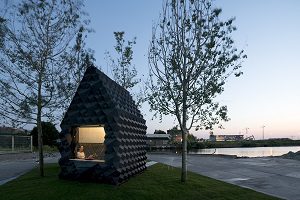To date, most 3D printed buildings have been built from concrete. Could 3D printed bioplastic be a more sustainable option? Additive manufacturing, or 3D printing, is a major part of the fourth industrial revolution and it will transform the construction sector, according to Zoubeir Lafhaj, an expert in the future of construction, from the graduate engineering school École Centrale de Lille, in France. ‘3D printing is a formidable tool to introduce robotisation into construction, and other kinds of innovation,’ he explains. Lafhaj adds that it will also help tackle environmental issues such as reducing waste.

Lafhaj is certain we need to move towards materials that use less energy, have a lower carbon footprint and produce less waste. Plastic is a good alternative because it is more environmentally friendly than concrete, Lafhaj says, but it also has another advantage. In dense urban environments, such as cities like Tokyo, it can be much easier and cheaper to import and move around. ‘In some areas in Japan there are not a lot of streets where you can construct new buildings,’ he explains. ‘They need new materials that can be brought in without big machines.’
3D printed bioplastic in Amsterdam
Examples of 3D printed bioplastic constructions can be seen on the canal-side site of Dus Architecture in Amsterdam. ‘We have entire 3D printed tiny houses, all kinds of staircases and walls standing here,’ says Hedwig Heinsman, co-founder of the company. ‘It looks like a modern-day ruin.’ A full-sized, 700m2 canal house is being made from 3D printed bioplastic on the site. One day the structure will be the firm’s offices and workspace. But this project is what the architects call ‘research & design by doing’ hence all the small prototype houses and bits of buildings.
The company has also tested its additive manufacturing technology elsewhere in Amsterdam. In 2015 it unveiled an 8m2 urban cabin that had been made using a black bio-based plastic – complete with printed outdoor bath tub. And they printed a massive 3D façade for the building that hosted the Netherland’s 6-month EU presidency in 2016. Heinsman says that one of the major advantages of 3D printed bioplastic construction is that it produces very little waste. ‘On an average building projects you have about 25% material waste,’ she explains. ‘With printing we really only use the material that we actually need.’
A mistake? The 3D printed bioplastic can be shredded and reused
The plastic being used to create the canal house is more than 50% bio-based (from linseed oil). An enormous printer heats it to produce streams of molten polymers and then layers them on top of each other to create the desired shape. The machine can construct building elements that are up to 5m tall. Once finished, these large segments are slotted together to create the final structure. ‘It is like a conventional building, because a conventional building is built with lots of different components –staircases, columns, walls – the difference is that we produce those components with 3D printing technology,’ explains Heinsman. Ultimately the architects see 3D printed bioplastic being used to mass produce customisable prefab architecture. ‘Prefab is a great way of building because it is fast and clean, but at present it is also very standardised,’ says Heinsman. ‘What we now offer is the advantages of large scale industrial production with the advantages of tailor made production, because we print with robots and bio-plastics.’
As well as creating whole buildings, the 3D printed bioplastic could also be used to help make specific components. Large construction and infrastructure projects, like bridges, often feature trusses – frameworks of beams that support the structure. With steel trusses one way to hold the framework together is to use resin joints that the steel beams can slot into – similar to the plastic joints used to hold the poles together in some tents and marques. These joints are usually formed using metal moulds, but these are expensive to make and are often thrown away at the end of each project.
Plastics from food waste
The EU project Barbara is working to create bio-based plastics that are able to withstand the 140ºC temperatures used to cure the resin, and can be used for a 3D printed bioplastic. These could then be used to print such truss joint moulds, explains project coordinator Lidia Garcia. ‘If we can produce something with the required properties that can bio-degrade, after small batch production, it would be more sustainable,’ she says. To develop bio-based plastics with the necessary thermal properties, the team are working to create plastic additives from food waste, such as broccoli, lemon, almond shells and carrots. ‘It is a way to boost the circular economy and valorise waste – we throw away a lot of food and a lot of crops,’ Garcia concludes.
Originally published on the site of youris.com.
Interesting? Then also read:
Bio concrete and other construction materials from local resources
Straw, an excellent construction material
Sustainable materials need certification and lobbies
